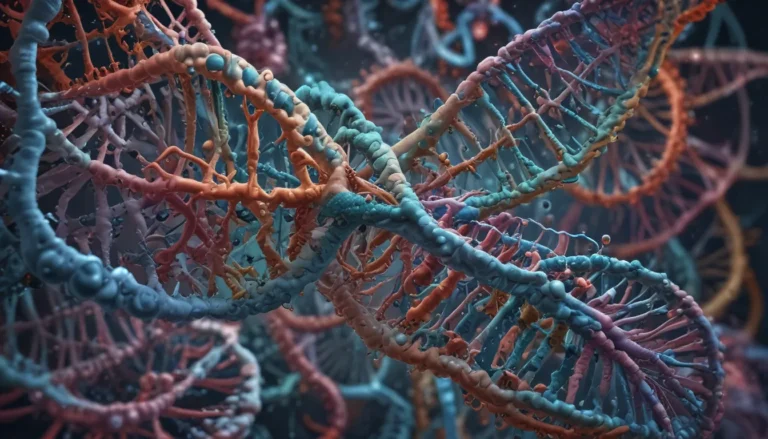A Note About Images: The images used in our articles are for illustration purposes only and may not exactly match the content. They are meant to engage readers, but the text should be relied upon for accurate information.
Gel electrophoresis is a captivating technique in the realm of biology that has revolutionized the way scientists separate and analyze molecules based on their size and charge. From DNA sequencing to genetic engineering, this method has become an indispensable tool in various fields of research. In this comprehensive guide, we will dive into the realm of gel electrophoresis, unveiling 18 fascinating facts about this essential technique. Join us on a journey to discover the secrets behind how gel electrophoresis has transformed our understanding of the building blocks of life.
Explore the Magic of Gel Electrophoresis
- Gel electrophoresis is a science technique that behaves like a DNA sorting game for scientists, allowing them to separate DNA fragments based on their size and charge.
- This captivating method enables researchers to study DNA, RNA, and proteins, providing valuable insights and solving mysteries in forensic investigations. It’s akin to wielding a super-powered microscope for genetic detectives.
Unraveling the Mysteries of Gel Electrophoresis
Gel electrophoresis is a pivotal technique used to separate and analyze DNA fragments in the realms of molecular biology and genetics. It provides scientists with a platform to dissect the intricate world of biomolecules based on their unique characteristics.
The Journey through Agarose Gel
The process of gel electrophoresis unfolds within an agarose gel matrix, crafted from seaweed extract. This gel matrix serves as the foundation for segregating DNA fragments, leveraging a porous structure to guide them through migration.
Beyond DNA Fingerprinting
Gel electrophoresis extends its prowess beyond DNA analysis, delving into the realms of RNA and proteins. By harnessing this technique, researchers can uncover the mysteries surrounding gene expression and protein structures.
Navigating the Buffer Systems
The choice of buffer system during gel electrophoresis plays a crucial role in the separation of DNA fragments. Common buffers like Tris-acetate-EDTA (TAE) and Tris-borate-EDTA (TBE) serve as essential allies in the quest for molecular separation.
Unveiling DNA Migration
DNA fragments embark on a journey towards the positive electrode during gel electrophoresis, driven by the negatively charged phosphate backbone. The speed of migration varies, with smaller fragments dashing ahead of their larger counterparts.
Illuminating DNA Bands
Ethidium bromide takes center stage as a fluorescent dye utilized to illuminate DNA bands on a gel. This miraculous dye seamlessly binds to DNA, emitting fluorescence when basking under the glow of ultraviolet light.
Size Determination of Unknown DNA Fragments
By juxtaposing the migration distances of unknown DNA fragments against known DNA markers, scientists can estimate the size of enigmatic fragments. This serves as a valuable asset in the realm of sequencing and genotyping applications.
Horizontal versus Vertical Gel Electrophoresis
Horizontal gel electrophoresis reigns supreme for routine DNA analysis, while vertical gel electrophoresis takes the spotlight when separating larger DNA fragments or proteins. This delightful dance between orientations enhances the versatility of gel electrophoresis.
Deciphering Genetic Code
Gel electrophoresis has metamorphosed the field of genetics, paving the way for advancements in DNA sequencing, genetic engineering, and genetic disorder exploration. This transformative technique enables scientists to unravel the intricate tapestry of genes and genomes.
Agarose Concentration Dynamics
The resolving power of the gel hinges on the delicately balanced agarose concentration. High agarose concentrations bestow a denser gel matrix, fostering superior separation of DNA fragments. However, prudent caution is warranted as high concentrations may lead to increased heat generation.
Unveiling PCR Products
Polymerase Chain Reaction (PCR) products stand under the discerning gaze of gel electrophoresis, allowing for the verification of successful amplification and scrutiny for any unexpected outcomes or contamination.
Harmonizing with Southern Blotting
Gel electrophoresis harmoniously intertwines with Southern blotting, a technique revered for detecting specific DNA sequences. Initiated with gel electrophoresis, this synergy propels DNA fragments towards a membrane for captivating hybridization.
Unearthing the Origins
The historical roots of gel electrophoresis trace back to the 1940s, with a blossoming evolution propelled by technological advancements and realms of molecular biology.
Embracing Diversity: DNA Agarose and Protein Polyacrylamide Gels
The dual realms of DNA agarose gels and protein polyacrylamide gels cater to the diverse landscape of molecular analysis. While agarose gels take the limelight in DNA analysis, their protein-based counterpart unfurls the mysteries of proteins based on size and charge.
Embarking on a Cost-Effective Odyssey
Gel electrophoresis stands as a cost-effective beacon amidst the sea of analytical techniques, rendering it accessible to researchers navigating fiscal constraints with aplomb.
Illuminating Genetic Mutations
The enigmatic patterns of DNA bands divulge the secrets of genetic mutations, offering insights into insertions, deletions, and single nucleotide polymorphisms (SNPs) that orchestrate the symphony of genetic diversity.
Embracing Automation
Automated gel electrophoresis systems herald a new era of precision, reproducibility, and high-throughput analysis. Guided by robotics and computer software, these systems orchestrate a symphony of electrophoresis processes with elegance and finesse.
In conclusion, the enchanting world of gel electrophoresis unveils a captivating narrative of separation and analysis of DNA fragments and biomolecules. This versatile technique weaves a tapestry of scientific progress across diverse research fields, illuminating the path to a deeper understanding of the genetic code.
Delve Deeper into the Enigmatic Realm of Gel Electrophoresis
Gel electrophoresis stands as a beacon of scientific progress, offering a panoramic view of DNA and proteins. This captivating technique beckons you to explore its intricate details further, unraveling even more mind-bending facts that underscore its significance in shaping the future of scientific discovery.
Embracing Knowledge Discovery
As we embark on a journey through the wondrous world of gel electrophoresis, the quest for knowledge becomes a thrilling adventure. Each fact unfolds a new chapter in the saga of scientific advancement, bolstering our understanding of DNA, RNA, and proteins.
Your Quest for Knowledge Continues
Intrigued by the enchanting complexities of gel electrophoresis? Dive deeper into the realm of facts and discoveries that illuminate the astounding capabilities of this transformative technique. As you delve into the depths of scientific exploration, let your curiosity guide you towards unlocking the mysteries of genetic code and biomolecular wonders.
Unleash Your Curiosity: FAQs
-
What is gel electrophoresis?
Gel electrophoresis is a laboratory technique that separates and analyzes molecules such as DNA, RNA, and proteins based on their size and charge. -
How does gel electrophoresis work?
By applying an electric field to a gel matrix, molecules migrate through the matrix, with smaller molecules traveling faster and farther than larger ones. -
What are the different types of gel electrophoresis?
Various types include agarose gel electrophoresis, polyacrylamide gel electrophoresis, and SDS-PAGE (sodium dodecyl sulfate-polyacrylamide gel electrophoresis). -
What are the applications of gel electrophoresis?
Gel electrophoresis finds diverse applications in DNA fingerprinting, genetic engineering, disease diagnostics, and drug development. -
Can gel electrophoresis analyze proteins?
Yes, gel electrophoresis can separate and analyze proteins, with SDS-PAGE being a popular technique for protein analysis. -
How has gel electrophoresis contributed to scientific advancements?
Its pivotal role in DNA sequencing, genetic engineering, and the discovery of genetic mutations have propelled scientific progress. -
Is gel electrophoresis safe?
While the technique itself is safe, caution is advised when handling chemicals and dyes used in gel electrophoresis experiments. -
Can gel electrophoresis be used in educational settings?
Indeed, gel electrophoresis is a valuable educational tool to impart molecular biology concepts to students. -
Are there alternatives to gel electrophoresis?
Capillary electrophoresis and next-generation sequencing offer alternatives with higher resolution and increased throughput. -
Can gel electrophoresis be automated?
Automated gel electrophoresis systems offer enhanced accuracy and efficiency through robotic and software-driven processes.
In the realm of scientific exploration, gel electrophoresis stands as a beacon of innovation and discovery, casting light on the intricacies of DNA and proteins. As we unravel the mysteries of this transformative technique, the horizon of knowledge expands, beckoning us to delve deeper into the enigmatic realm of molecular biology and genetics. Let your curiosity guide you as you journey through the captivating world of gel electrophoresis, where each fact unveils a new dimension of scientific marvel.






